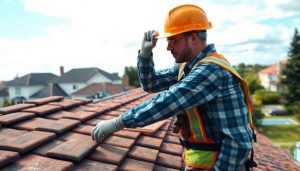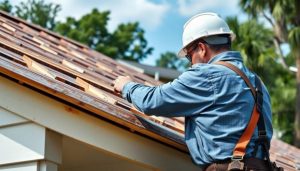As hurricane season looms, the importance of fortifying our roofs cannot be overstated. A well-prepared roof isn’t just a barrier against wind and rain; it’s our first line of defense in safeguarding our homes and loved ones from nature’s fury. By taking proactive steps, we can ensure our roofs withstand the storms and minimize potential damage.
Preparation is key. We might not control the weather or the design of our homes, but we can certainly control how ready we are. From assessing our roof’s condition to making necessary repairs and securing loose shingles, each action contributes to our home’s resilience. Enlisting a professional’s expertise can further bolster our efforts, addressing vulnerabilities before they become costly problems.
With annual assessments and timely maintenance, we can face the hurricane season with confidence. It’s not just about weathering the storm; it’s about ensuring peace of mind when the skies darken and the winds pick up.
Understanding Hurricane Threats to Your Roof
Our roofs face significant risks during hurricane season. High-speed winds, reaching up to 150 mph, can cause considerable damage. For instance, winds can lift shingles from their base, exposing the roof’s internal structure to water penetration. Older asphalt shingles withstand winds only up to 50-60 mph, making them vulnerable.
Strong winds often lead to flying debris and tree branches impacting roofs. These can cause structural damage or dislodge roof elements. It’s crucial not only to strengthen the roof itself but also to manage the surrounding environment, like trimming overhanging branches, to minimize risks.
According to surveys following the 2004 and 2005 hurricanes, about 95% of those who filed insurance claims experienced roof damage. This statistic underscores the importance of preparing roofs for such events. Even if we’re located inland, the threat of wind damage remains significant.
Addressing these vulnerabilities requires quality materials and proper installation. Six-nailed shingles offer better resistance, anchoring shingles more securely than four-nailed ones. For comprehensive protection, let’s evaluate and upgrade roofing materials when necessary.
Further information on preparing roofs for hurricanes is available at Pearland Roofing for insights on securing roofing systems. Strong roofs are crucial for home protection during these intense weather events, and Pearland Roofing provides practical, reliable solutions.
Essential Preparations for Your Roof

Proactive roof preparation is vital for hurricane season. Here, we cover three critical steps to reinforce your roof’s resilience against powerful storms.
Conducting a Roof Inspection
A thorough inspection forms the foundation of hurricane readiness. With a scheduled professional roof inspection, experts assess areas such as the roof membrane for tears or aging signs and inspect flashings for secure attachment. Also, mounted equipment gets evaluated for proper sealing. This comprehensive approach identifies weaknesses that warrant repairs, ensuring no vulnerability goes unnoticed.
Securing Loose Shingles and Tiles
Prevent roof material from becoming airborne by securing every shingle and tile. Roof adhesive aids in firmly affixing loose parts, with application recommended weeks before hurricane forecasts. Re-nailing or replacing worn shingles provides additional security. These steps minimize the risk of roof exposure during strong winds.
Cleaning and Maintaining Gutters
Proper water flow is crucial in heavy rains, making gutter maintenance essential. Clear debris from gutters, downspouts, and drains to avoid blockages that lead to water intrusion. Regular checks ensure gutters are correctly installed and effective, protecting your home from water damage.
Strengthening Your Roofing System

Strengthening our roofing system ensures resilience against hurricane forces and minimizes potential damage. Utilizing proven methods enhances the roof’s endurance and provides greater peace of mind during severe weather.
Using Hurricane Straps and Ties
Hurricane straps represent a pivotal advancement in safeguarding roofs against storm damage. These metal ties, when installed correctly, secure the roof trusses or framework more effectively to the structure of the house. Older homes may require new installations, while newer homes in hurricane-prone areas often have them pre-installed. By attaching straps at points where rafters meet studs, we ensure a robust foundation. Misaligned studs and rafters necessitate structural ties to maintain integrity.
Reinforcing Flashing
Flashing acts as a critical barrier against water intrusion, especially during hurricanes. Positioned where roof features like chimneys or vents meet the roof’s surface, flashing prevents leaks. Proper maintenance involves inspecting for any gaps or decay. If issues are present, resealing, patching, or replacing becomes essential. We recommend periodic checks to ensure the flashing remains in optimal condition.
Protecting Surrounding Areas
In preparing for hurricanes, safeguarding the areas around your home is as crucial as reinforcing the roof itself. By focusing on nearby elements, we can minimize potential hazards and prevent further damage during storms.
Trimming Trees and Removing Debris
Overhanging branches and accumulated debris on your roof become even more dangerous during hurricanes. Weak or diseased branches could easily break, falling onto the roof and causing damage. It’s essential to trim back any branches that hang over your roof and remove debris on the roof itself. This practice not only prevents immediate threats during storms but also deters pests like rodents and insects, which may seek shelter in debris. Additionally, the weight of wet leaves and branches can strain the roof’s structural integrity. Consistently keeping the roof clear of debris ensures the roof remains healthy and less prone to damage.
Securing Outdoor Items
High winds can turn unsecured outdoor items into hazardous projectiles, causing significant damage to both the roof and property. It’s crucial to secure or store patio furniture, grills, and garbage cans to protect against these dangers. For added protection, use tie-downs or relocate items to a garage or shed. Properly securing all potential projectiles enhances safety during a hurricane and aligns with our overall strategy of comprehensive storm preparation.
Post-Storm Actions
After a hurricane, it’s crucial to take specific actions to assess and repair any damage to your roof. Quick response and effective solutions minimize long-term issues.
Safety Inspections and Repairs
We begin with a thorough safety inspection. Assess for missing shingles or tiles, and check for structural damages, like warped beams. Engage a roofing professional for an in-depth evaluation if safety is compromised. Prioritize immediate repairs to prevent further water damage or structural weakening. Use roof tarps as temporary shields while waiting for professional help.
Ensuring Insurance Documentation
Document the damage comprehensively to streamline insurance claims. Take detailed photos and videos of roof damage, highlighting any missing materials or visible interior leaks. Record all repair receipts and assessments from professionals for evidence. Contact your insurance provider promptly to begin the claim process.
Conclusion
Preparing our roofs for hurricane season is more than just a precaution; it’s a necessity for safeguarding our homes and families. By taking proactive steps like regular inspections and timely repairs, we enhance our resilience against nature’s fury. Investing in quality materials and professional guidance ensures that our roofs stand strong when it matters most. Let’s not overlook the importance of managing our surroundings and securing outdoor items to minimize risks. With these strategies in place, we can face hurricane season with greater confidence and peace of mind, knowing we’ve done our utmost to protect what matters most.

